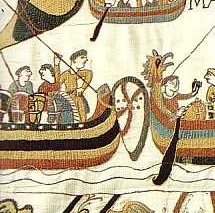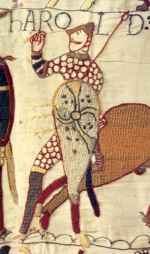What is the origin of this cross?
(Puzzle 007)
Norman? Saxon? Both? Neither?
We now have the answer.

We noticed this Curved Cross when looking at the Bayeux Tapestry (the 11th century cartoon strip telling the story of the Norman invasion of Saxon England) and wondered; was the cross style Norman? Saxon? Both? Neither?
Heraldically it would be called an Serpentine Cross, meaning S-shaped, but what is the significance of this curvature?
Nobody knows who embroidered the 70 metre (230 foot) long Bayeux Tapestry, but it was probably done in England by an Anglo-Saxon artist or seamstress. The artist is no more likely to have been on the battle-field than Queen Matilda or whoever commissioned the work. The caricature and surreal nature of the Tapestry shows exaggerated poses of the warriors. Therefore we did not know whether the curved arms of the cross were accurate and significant. And if there was significance, what was it? Well, we now have the answer.
The Curved Cross can be seen on the shield hanging from the stern of the Norman boat crossing the Channel to Hastings. The Normans attacked on horseback and favoured the kite-shaped shields which protected their legs. The Curved Cross therefore it was initially assumed to be a Norman design.
If it were a Christian cross, the bends or twists could represent the contorted body of Jesus in agony on the cross. The design is pattéed and there are clear similarities with the Lauburu and the Swastika. It is a Wavy Cross; an apt name for a style adopted by these seafarers. The cross arms undulate, hence the heraldic names Undé Cross (also spelt Onde, Oundy and Oundé). However, this artwork was embroidered at least one hundred years before heraldic symbols were common and this invasion was not part of any Christian religious crusade - both Normans and Saxons claimed that Christ was on their side.
In the picture on the right we see King Harold, with a distinctive Saxon moustache, plucking the arrow from his eye. Harold was the English king, so what was he doing with a Norman shield if indeed it was a 'Norman Cross'? The Saxons (although they used horses to reach the battle field) fought on foot and used round shields.
We've been fortunate in getting answers to these questions from a historian at Reading museum that houses the only full-size replica of the Tapestry.
Firstly, the cross here is not meant to be a Christian symbol. As mentioned above, this appeared long before heraldry.
Shields are designed to withstand a fair battering and were traditionally reinforced with iron cross-pieces. Shields were also curved to slightly wrap around the bearer's body offering some protection against blows from the side. The curves of the iron cross-pieces are following the curvature of the shield. This is why we see the design used by both Saxons and Normans.
So this file is now 'closed", but if you have further information or have seen this wavy cross elsewhere, please email us.
(See also Bent Cross and Norman Cross)


